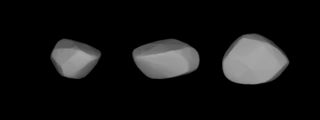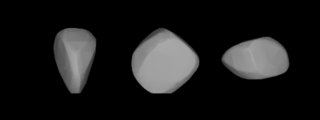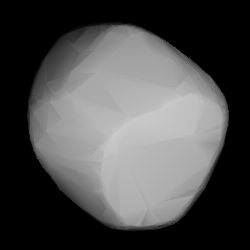6433 Enya, provisional designation 1978 WC, is a stony background asteroid from the inner regions of the asteroid belt, approximately 7 kilometers in diameter. It was discovered on 18 November 1978, by Czech astronomer Antonín Mrkos at the Kleť Observatory in the Czech Republic. It was named for Irish musician Enya.
(9928) 1981 WE9, provisional designation 1981 WE9, is a stony Florian asteroid from the inner regions of the asteroid belt, approximately 3 kilometers in diameter. It was discovered on 16 November 1981, by astronomers at Perth Observatory in Bickley, Australia.
12696 Camus, provisional designation 1989 SF1, is a carbonaceous background asteroid from the central region of the asteroid belt, approximately 9 kilometers in diameter.
11277 Ballard (provisional designation 1988 TW2) is a Phocaea asteroid from the inner regions of the asteroid belt, approximately 6.3 kilometers (3.9 miles) in diameter. It was discovered on 8 October 1988, by American astronomer couple Carolyn and Eugene Shoemaker at the Palomar Observatory in California. The assumed S-type asteroid has a rotation period of at least 10 hours. It was named for American marine scientist Robert Ballard.
1240 Centenaria, provisional designation 1932 CD, is a background asteroid from the outer regions of the asteroid belt, approximately 60 kilometers in diameter. It was discovered on 5 February 1932, by astronomer Richard Schorr at the Bergedorf Observatory in Hamburg, Germany. The assumed C-type asteroid has a rotation period of 11.3 hours. It was named for the 100th anniversary of the discovering observatory.

1241 Dysona, provisional designation 1932 EB1, is a dark background asteroid from the outer regions of the asteroid belt, approximately 77 kilometers in diameter. It was discovered on 4 March 1932, by English astronomer Harry Edwin Wood at the Union Observatory in Johannesburg, South Africa. The asteroid was named after English astronomer Frank Watson Dyson.
1267 Geertruida, provisional designation 1930 HD, is a carbonaceous background asteroid from the inner regions of the asteroid belt, approximately 20 kilometers in diameter. Discovered by astronomer Hendrik van Gent at Johannesburg Observatory in 1930, the asteroid was later named after Geertruid Pels, sister of Dutch astronomer Gerrit Pels.
2571 Geisei, provisional designation 1981 UC, is a stony Florian asteroid from the inner regions of the asteroid belt, approximately 6 kilometers in diameter. It was discovered by Japanese astronomer Tsutomu Seki at Geisei Observatory on 23 October 1981, and named for the Japanese village of Geisei.
5385 Kamenka, provisional designation 1975 TS3, is a background asteroid from the outer regions of the asteroid belt, approximately 16 kilometers (10 miles) in diameter. It was discovered on 3 October 1975, by Soviet astronomer Lyudmila Chernykh at the Crimean Astrophysical Observatory in Nauchnij, on the Crimean peninsula. The presumed C-type asteroid has a rotation period of 6.68 hours. It was named for the Ukrainian town of Kamianka.

1836 Komarov is a carbonaceous Dorian asteroid from the central region of the asteroid belt, approximately 22 kilometers in diameter. It was discovered on 26 July 1971 by Russian astronomer Nikolai Chernykh at Crimean Astrophysical Observatory in Nauchnij on the Crimean peninsula. It was named after Soviet cosmonaut Vladimir Komarov.
1383 Limburgia, provisional designation 1934 RV, is a carbonaceous asteroid from the outer region of the asteroid belt, approximately 23 kilometers in diameter. It was discovered on 9 September 1934, by Dutch astronomer Hendrik van Gent at the Leiden Southern Station, annex to the Johannesburg Observatory in South Africa. It is named for the Dutch province Limburg.
4904 Makio, provisional designation 1989 WZ, is a stony asteroid from the inner regions of the asteroid belt, approximately 8 kilometers in diameter. It was discovered by Japanese astronomers Yoshikane Mizuno and Toshimasa Furuta at Kani Observatory on 21 November 1989. It was named after Japanese astronomer Makio Akiyama.

1607 Mavis, provisional designation 1950 RA, is a stony asteroid from the central region of the asteroid belt, approximately 12 kilometers in diameter. It was discovered on 3 September 1950, by South African astronomer Ernest Johnson at Johannesburg Observatory in South Africa. It was later named after the wife of astronomer Jacobus Bruwer.
1405 Sibelius, provisional designation 1936 RE, is a stony Florian asteroid from the inner regions of the asteroid belt, approximately 8 kilometers in diameter. It was discovered on 12 September 1936, by Finnish astronomer Yrjö Väisälä at Turku Observatory in Southwest Finland. The asteroid was named after composer Jean Sibelius.
3823 Yorii, provisional designation 1988 EC1, is a carbonaceous asteroid from the outer region of the asteroid belt, approximately 11 kilometers in diameter.
4760 Jia-xiang, provisional designation 1981 GN1, is a background asteroid from the inner regions of the asteroid belt, approximately 5 kilometers (3 miles) in diameter. It was discovered on 1 April 1981, by astronomers at Harvard University's Oak Ridge Observatory in Massachusetts, United States. The presumed stony S-type asteroid was named after Chinese astronomer Zhang Jiaxiang. It has a rotation period of 14.96 hours.
6181 Bobweber, provisional designation 1986 RW, is a stony asteroid from the inner regions of the asteroid belt, approximately 5 kilometers in diameter. It was discovered on 6 September 1986, by American astronomer Eleanor Helin at the U.S. Palomar Observatory in California, and named after astronomer Robert Weber.
(6265) 1985 TW3 (provisional designation 1985 TW3) is a background asteroid and binary system from the inner regions of the asteroid belt. It was discovered on 11 October 1985, by astronomer by T. F. Fric and Richard Gilbrech at the Palomar Observatory in California. It is the only minor-planet discovery for these two astronomers. The stony L-type asteroid measures approximately 5 kilometers (3.1 miles) in diameter and has a rotation period of 2.7 hours. Its 1.2-kilometer sized minor-planet moon was discovered in July 2007 and announced the following month.
10208 Germanicus, provisional designation 1997 QN1, is a stony Florian asteroid and binary system from the inner regions of the asteroid belt, approximately 3.5 kilometers in diameter.
(7563) 1988 BC is a background asteroid from the central region of the asteroid belt, approximately 16 kilometers in diameter. It was discovered on 16 January 1988, by Japanese amateur astronomer Takuo Kojima at the YGCO Chiyoda Station in the Kantō region of Japan. The asteroid has a rotation period of 6.5 hours.



